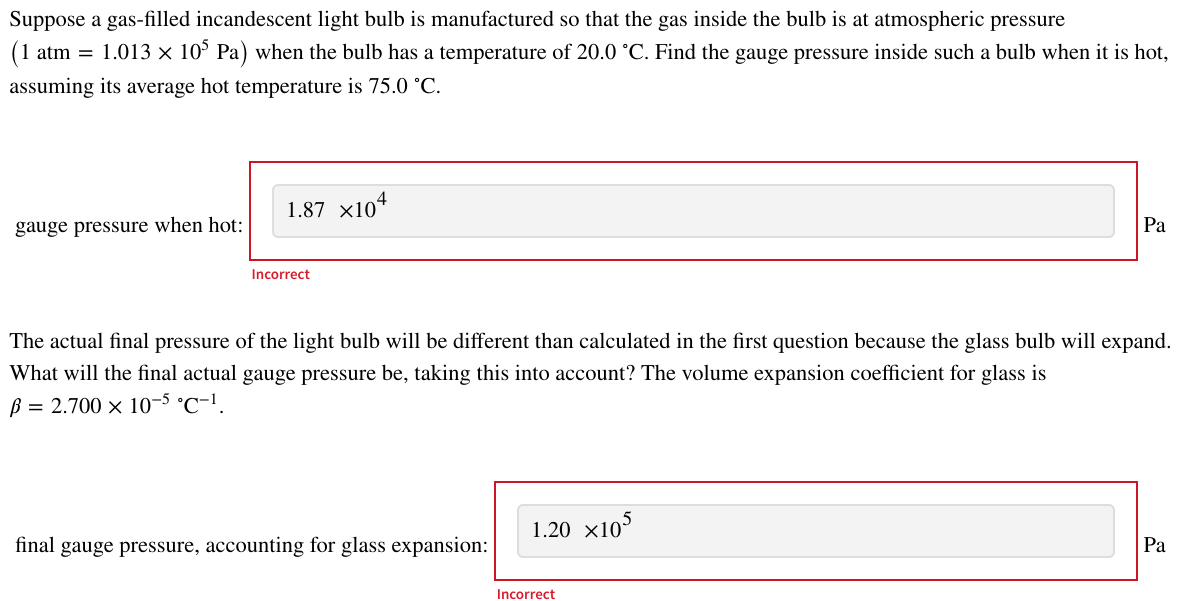Suppose a gas-filled incandescent light bulb is manufactured so that the gas inside the bulb is at atmospheric pressure (1 atm = 1.013 × 105 Pa) when the bulb has a temperature of 20.0 °C. Find the gauge pressure inside such a bulb when it is hot, assuming its average hot temperature is 75.0 °C. gauge pressure when hot: 1.87 X104 Incorrect The actual final pressure of the light bulb will be different than calculated in the first question because the glass bulb will expand. What will the final actual gauge pressure be, taking this into account? The volume expansion coefficient for glass is ß = 2.700 x 10-5 °C-1. final gauge pressure, accounting for glass expansion: 1.20 ×105 Pa Incorrect Pa
Suppose a gas-filled incandescent light bulb is manufactured so that the gas inside the bulb is at atmospheric pressure (1 atm = 1.013 × 105 Pa) when the bulb has a temperature of 20.0 °C. Find the gauge pressure inside such a bulb when it is hot, assuming its average hot temperature is 75.0 °C. gauge pressure when hot: 1.87 X104 Incorrect The actual final pressure of the light bulb will be different than calculated in the first question because the glass bulb will expand. What will the final actual gauge pressure be, taking this into account? The volume expansion coefficient for glass is ß = 2.700 x 10-5 °C-1. final gauge pressure, accounting for glass expansion: 1.20 ×105 Pa Incorrect Pa
Elements Of Electromagnetics
7th Edition
ISBN:9780190698614
Author:Sadiku, Matthew N. O.
Publisher:Sadiku, Matthew N. O.
ChapterMA: Math Assessment
Section: Chapter Questions
Problem 1.1MA
Related questions
Question

Transcribed Image Text:Suppose a gas-filled incandescent light bulb is manufactured so that the gas inside the bulb is at atmospheric pressure
(1 atm = 1.013 × 105 Pa) when the bulb has a temperature of 20.0 °C. Find the gauge pressure inside such a bulb when it is hot,
assuming its average hot temperature is 75.0 °C.
gauge pressure when hot:
1.87 X104
Incorrect
The actual final pressure of the light bulb will be different than calculated in the first question because the glass bulb will expand.
What will the final actual gauge pressure be, taking this into account? The volume expansion coefficient for glass is
ß = 2.700 x 10-5 °C-1.
final gauge pressure, accounting for glass expansion:
1.20 ×105
Pa
Incorrect
Pa
Expert Solution
This question has been solved!
Explore an expertly crafted, step-by-step solution for a thorough understanding of key concepts.
This is a popular solution!
Trending now
This is a popular solution!
Step by step
Solved in 2 steps with 2 images

Knowledge Booster
Learn more about
Need a deep-dive on the concept behind this application? Look no further. Learn more about this topic, mechanical-engineering and related others by exploring similar questions and additional content below.Recommended textbooks for you

Elements Of Electromagnetics
Mechanical Engineering
ISBN:
9780190698614
Author:
Sadiku, Matthew N. O.
Publisher:
Oxford University Press

Mechanics of Materials (10th Edition)
Mechanical Engineering
ISBN:
9780134319650
Author:
Russell C. Hibbeler
Publisher:
PEARSON

Thermodynamics: An Engineering Approach
Mechanical Engineering
ISBN:
9781259822674
Author:
Yunus A. Cengel Dr., Michael A. Boles
Publisher:
McGraw-Hill Education

Elements Of Electromagnetics
Mechanical Engineering
ISBN:
9780190698614
Author:
Sadiku, Matthew N. O.
Publisher:
Oxford University Press

Mechanics of Materials (10th Edition)
Mechanical Engineering
ISBN:
9780134319650
Author:
Russell C. Hibbeler
Publisher:
PEARSON

Thermodynamics: An Engineering Approach
Mechanical Engineering
ISBN:
9781259822674
Author:
Yunus A. Cengel Dr., Michael A. Boles
Publisher:
McGraw-Hill Education

Control Systems Engineering
Mechanical Engineering
ISBN:
9781118170519
Author:
Norman S. Nise
Publisher:
WILEY

Mechanics of Materials (MindTap Course List)
Mechanical Engineering
ISBN:
9781337093347
Author:
Barry J. Goodno, James M. Gere
Publisher:
Cengage Learning

Engineering Mechanics: Statics
Mechanical Engineering
ISBN:
9781118807330
Author:
James L. Meriam, L. G. Kraige, J. N. Bolton
Publisher:
WILEY